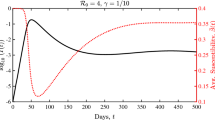Abstract
Developing the ability to comprehensively study infections in small populations enables us to improve epidemic models and better advise individuals about potential risks to their health. We currently have a limited understanding of how infections spread within a small population because it has been difficult to closely track and infection within a complete community. This paper presents data closely tracking the spread of an infection centered on a student dormitory, collected by leveraging the residents’ use of cellular phones. This data is based on daily symptom surveys taken over a period of four months and proximity tracking through cellular phones. We demonstrate that using a Bayesian, discrete-time multi-agent model of infection to model the real-world symptom report and proximity tracking records can give us important insights about infections in small populations
Access this chapter
Tax calculation will be finalised at checkout
Purchases are for personal use only
Preview
Unable to display preview. Download preview PDF.
Similar content being viewed by others
References
Eubank, S., Guclu, H., Kumar, V., Marathe, M., Srinivasan, A., Toroczkai, Z., Wang, N.: Modelling disease outbreaks in realistic urban social networks. Nature 429, 180–184 (2004)
Isella, L., Stehle, J., Barrat, A., Cattuto, C., Pinton, J., Van den Broeck, W.: What’s in a crowd? analysis of face-to-face behavioral networks. J. Theor. Biol. 271, 166–180 (2010)
Salathe, M., Kazandjieva, M., Lee, J., Levis, P., Feldman, M., Jones, J.: A high-resolution human contact network for infectious disease transmission. Proc. Natl. Acad. Sci (USA) 107, 22020–22025 (2010)
Hufnagel, L., Brockmann, D., Geisel, T.: Forecast and control of epidemics in a globalized world. Proc. Natl. Acad. Sci. USA 101, 15124–15129 (2004)
Stehle, J., Voirin, N., et al.: Simulation of an SEIR infectious disease model on the dynamic contact network of conference attendees. BMC Medicine 9(1), 87 (2011)
Dong, W., Lepri, B., Pentland, A.: Modeling the coevolution of behaviors and social relationships using mobile phone data. In: Proc ACM MUM (2011)
Dong, W., Heller, K., Pentland, A.: Modeling Infection with Multi-agent Dynamics. arXiv 1201.xxxx [cs.MA, cs.SI]
Author information
Authors and Affiliations
Editor information
Editors and Affiliations
Rights and permissions
Copyright information
© 2012 Springer-Verlag Berlin Heidelberg
About this paper
Cite this paper
Dong, W., Heller, K., Pentland, A.(. (2012). Modeling Infection with Multi-agent Dynamics. In: Yang, S.J., Greenberg, A.M., Endsley, M. (eds) Social Computing, Behavioral - Cultural Modeling and Prediction. SBP 2012. Lecture Notes in Computer Science, vol 7227. Springer, Berlin, Heidelberg. https://doi.org/10.1007/978-3-642-29047-3_21
Download citation
DOI: https://doi.org/10.1007/978-3-642-29047-3_21
Publisher Name: Springer, Berlin, Heidelberg
Print ISBN: 978-3-642-29046-6
Online ISBN: 978-3-642-29047-3
eBook Packages: Computer ScienceComputer Science (R0)




